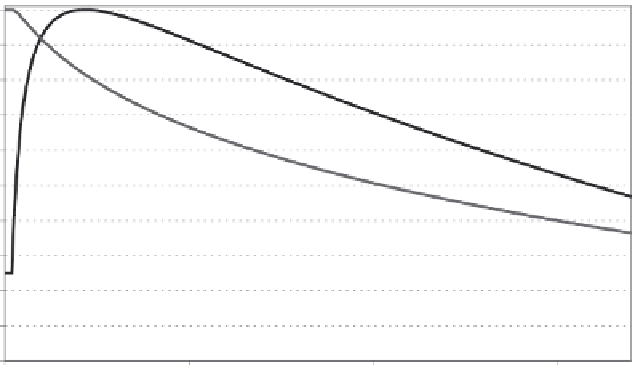Biomedical Engineering Reference
In-Depth Information
Power control
: This is the simplest form of control, where con-
stant power is applied during the ablation procedure.
Temperature control
: Thermal sensors are integrated into the
RF electrode, and applied power is controlled such that tissue
temperature measured by these sensors is kept at a certain target
value (typically near 100°C) during the ablation period.
Impedance control
: Tissue impedance, which is measured
between the RF electrode and the reference electrode (i.e.,
ground pad), represents a weighted average of the electrical
resistivity (= 1/conductivity) of all tissue that serves as electrical
pathway between the two electrodes. The weighting is such that
tissue close to the RF electrode has highest influence (i.e., regions
with high electric current densities have highest weighting; see
also Figure 9.5). Therefore, changes in electrical conductivity
around the electrode will have a considerable effect on measured
impedance. As tissue temperature increases, the electrical con-
ductivity rises, which results in a drop in impedance (note again
that impedance is inversely related to electrical conductivity). As
tissue vaporizes above 100°C, an increase in impedance results
(details described in Section 9.2.2). After impedance exceeds a
defined threshold level, RF power is discontinued for a certain
time period during which tissue cools down, vapor settles, and
impedance returns to baseline (see Figure 9.3). Subsequently, RF
power is reapplied at a lower level.
120
100
80
60
40
20
0
0
1
2
3
4
5
6
7
8
t (min)
FIGURE 9.3
Impedance control of applied RF power. Once tissue
impedance (
Z
) exceeds a defined threshold (arrow) as a result of vapor-
ization, power is discontinued and reapplied after a brief period.
temperature is moved deeper into the tissue from the electrode
surface (Figure 9.4) (Haemmerich 2003a). This results in an over-
all increase of temperature throughout the tissue, producing a
larger ablation zone. During cardiac ablation, a similar convec-
tive cooling effect is achieved by the blood flowing by the elec-
trode (for more details see Section 9.3.2 on cardiac ablation).
9.2.2 Electrical tissue Conductivity
at radiofrequencies
Electrical conductivity quantifies how well a certain material
conducts electric current. Electrical tissue conductivity is one of
the properties affecting heating during RF ablation (see Equation
9.2), and generally depends on frequency (Gabriel 1996b). In this
chapter we are concerned with the radiofrequency range of ~450-
500 kHz at which RF ablation is performed, and in the following
9.2.1 Electrode Cooling
Cooling of the RF electrode is a commonly used method that
allows for increased ablation zone dimensions. In the absence of
active cooling of the electrode, highest temperature is observed
next to the electrode (Figure 9.4). Through circulation of a cool-
ant within the electrode (typically water), both the electrode and
tissue in close proximity are cooled, and the location of highest
100
90
80
Cooling
No cooling
70
60
50
40
30
20
10
0
0
5
10
15
D
(mm)
FIGURE 9.4
Tissue temperature (
T
) as a function of distance (
D
) from the RF electrode. Without cooling, location of maximum tissue tempera-
ture is adjacent to the electrode. With cooling, this location is moved further from the electrode, resulting in a larger ablation zone. (Reproduced
from Haemmerich, D., Chachati, L., Wright, A.S., Mahvi, D.M., Lee, F.T. Jr., and Webster, J.G.,
IEEE Transactions on Biomedical Engineering
50,
2003a. © IEEE.)


